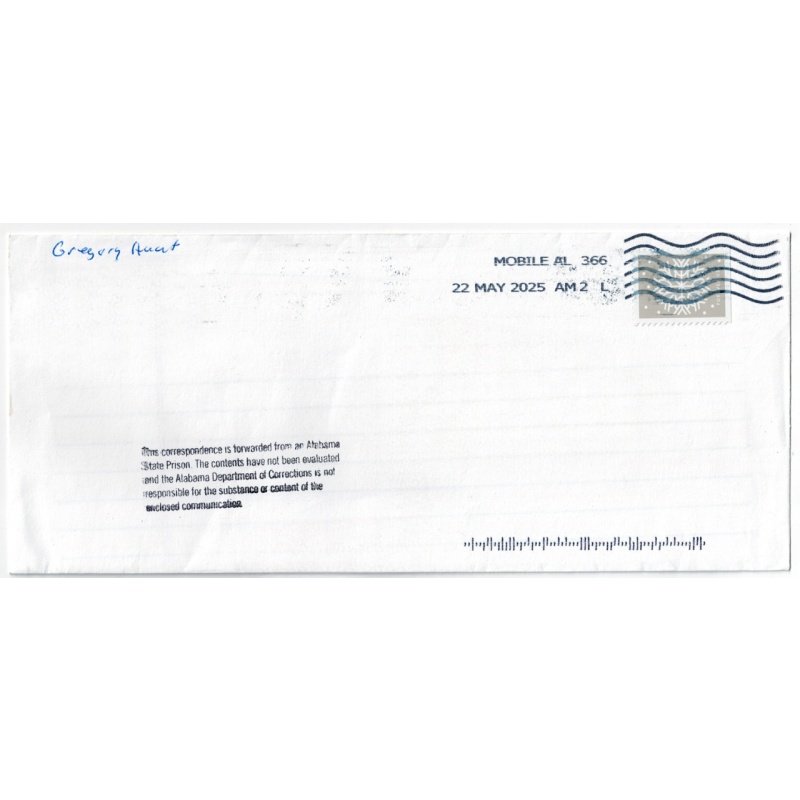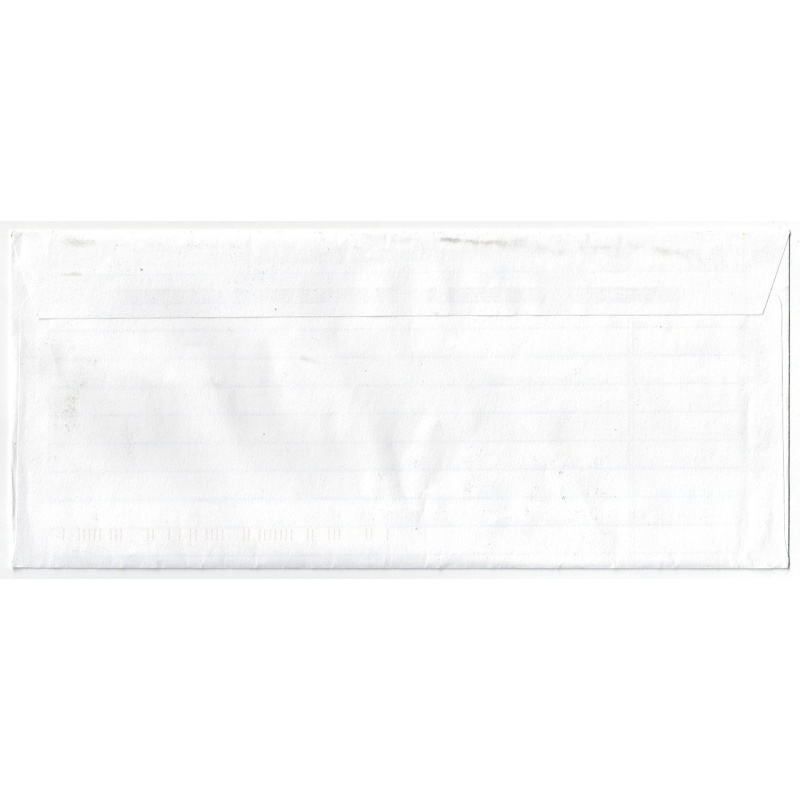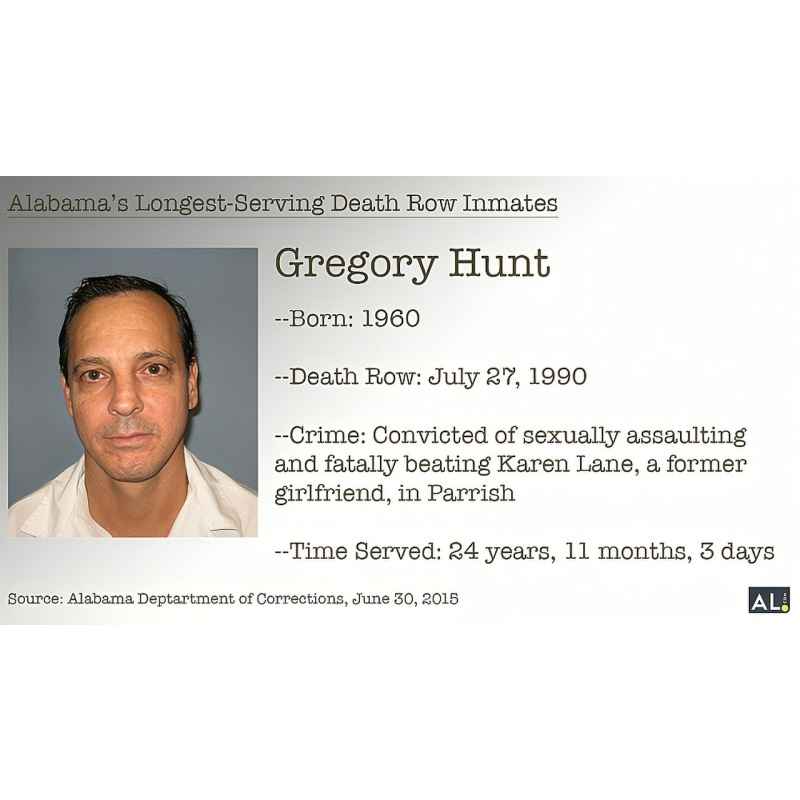GREGORY HUNT | Death Row | Minister Scheduled to Be Executed by Nitrogen Hypoxia in Alabama Between Midnight on June 10, 2025, and 6 am On June 11, 2025, for the Capital Murder of Karen Lane | ALS
LongfellowSerenade 67
Gregory Hunt, an Alabama death row inmate, is scheduled for execution by nitrogen gas on June 10, 2025, for the 1988 murder and sexual assault of Karen Lane. Hunt is representing himself in his final appeal, disputing the sexual assault charge, which is a key element of his capital murder conviction. His defense argues that the prosecution's claims about the sexual assault are misleading, citing Lane's prior hysterectomy. Efforts are underway to halt the execution, with arguments against capital punishment and concerns about trial fairness, including ineffective counsel and the lack of mitigating factors. Hunt's execution is part of a series of executions scheduled across multiple states, raising broader questions about capital punishment.
$60.00
- Postage
-
Standard Shipping
$0.00 to United States
Get Additional Rates
- Select Country
- Zip/Post Code
- Quantity
Description
Gregory Hunt. Autographed Letter, Signed. Handwritten, Commercial #10 (4.125 × 9.5 envelope). Mobile, AL. May 22, 2025. Content unknown. SEALED.
Gregory Hunt, born in 1957 in Alabama, was convicted in 1990 for the brutal 1988 murder and sexual assault of Karen L. Sanders Lane. Despite his claims of innocence regarding the sexual assault, forensic evidence and a confession letter led to his conviction on three counts of capital murder. Sentenced to death, Hunt has spent over three decades on death row, with his execution scheduled for 2025. His case underscores the complexities of the criminal justice system, the enduring impact on victims' families, and the societal debates surrounding capital punishment.
Echoes of a Crime: The Gregory Hunt Case
Gregory Hunt was born in 1957 in Alabama. Details about his early life, family background, and education remain scarce in public records. Prior to his conviction, there is limited information regarding his employment history or known associations.
On August 2, 1988, Karen Lane was found brutally murdered in her apartment in Walker County, Alabama. The crime scene was horrific: Lane had sustained 60 injuries, including 20 to the head, multiple fractured ribs, a fractured breastbone, internal organ damage, and a torn aorta. Evidence indicated she had been sexually assaulted, with semen found in her mouth and signs of assault with a broomstick. A letter written by Hunt admitting responsibility for her death further implicated him.
In March 1989, Hunt was charged with three counts of capital murder: intentional murder during sexual abuse in the first degree and intentional murder during a burglary in the first degree. By June 1990, a jury found him guilty on all counts, recommending the death penalty by an 11-1 vote. The court sentenced him to death on July 27, 1990.
Hunt's appeals have centered on claims that he did not sexually assault Lane, arguing that his trial attorneys failed to present mitigating circumstances from his background. Despite these claims, courts have consistently upheld his conviction and sentence.
Impact on the community, highlighting issues related to sexual violence and the death penalty. Lane's family and the public have expressed enduring grief and a desire for justice. The brutality of the crime and the subsequent legal proceedings have been covered extensively in the media, reinforcing the importance of victim advocacy and legal reforms.
As of 2025, Hunt remains on death row in Alabama, with his execution scheduled for later this year. He has expressed remorse for killing Lane but continues to deny the sexual assault allegations.
The Hunt case serves as a somber reminder of the devastating effects of violent crime and the complexities of the legal system. It underscores the necessity for thorough investigations, fair trials, and support for victims' families. While the notion of obtaining an autographed item from Hunt may intrigue some collectors due to its rarity, it is essential to approach such interests with sensitivity to the victims and their loved ones.
VIDEO: Scheduled Execution (06/10/25): Gregory Hunt – Alabama Death Row – 1988 Murder of Karen Lane | https://youtu.be/jmHjXbzxXUk
Archiving Protocol:
• Handled with White Gloves ab initio
• Photo Pages/Sheet Protectors: Heavyweight Clear Sheet Protectors, Acid Free & Archival Safe, 8.5 × 11, Top Load
• White Backing Board—Acid Free
Shipping/Packaging: Rigid Mailer 9.5 × 12.5. The Kraft cardboard is white, self-seal, and stay-flat, ensuring it does not bend. Heavy cardboard, which has strong resistance to bending and tearing, makes each rigid mailer sturdy. These mailers are significantly thicker than those used by the USPS. Shipping cost is never more than it absolutely has to be to get it from me to you.
Payments & Returns
- Payment Methods
- PayPal, Money Order
Postage & Shipping
- Item Location
- 49858, Michigan, United States
- Ships To
- Worldwide
- Pick-ups
- No pick-ups
- Shipping Instructions
- Shipping costs to international destinations will be applied to this auction. Please contact us if you have any questions about shipping to your location.
- Returns Accepted
- No

-800x800.jpg)




-500x500.jpg)


-500x500.jpg)

